Advancements in Thermoelectric Generator Design: Exploring Heat Exchanger Efficiency and Material Properties
Abstract
1. Introduction
2. Methodology
2.1. Simulation Assumptions and Governing Equations
- The system operates in a steady state.
- The fluid is incompressible and does not undergo a phase change.
- Convective and radiative heat losses at the boundaries are neglected (adiabatic conditions).
- Thermal contact resistances are neglected.
- The cross-sectional areas and lengths of P-type and N-type thermoelectric materials are equal.
- The power consumption of the cooling system pump is not considered.
- The design of the clamping element is excluded from analysis.
2.2. Mathematical Modeling of Thermoelectric Generator Performance
2.3. Thermal Energy Conversion in TEG Modules: Efficiency and Heat Flow Analysis
2.4. Fins’ Function
3. Numerical Methods
3.1. Design and Simulation of Square Heat Exchangers in Thermoelectric Modules
- Plate Fin Heat Exchanger: Our choice for the plate fin heat exchanger design was influenced by its typical application in electronic components cooling, where flat fins increase heat transfer area. We based our model on Luo et al. [112], with fin thickness (w) of 1.5 mm and fin spacing (d) of 4 mm. Plate fin heat exchangers, while efficient, are more complex to manufacture than simpler designs like cavity heat exchangers. Due to intricate fin structures, this complexity requires precise fabrication techniques and can lead to longer production times, the need for specialized skills, and a higher risk of manufacturing errors. Addressing these challenges is essential for their effective use in thermoelectric generators, particularly given their benefits in waste heat recovery.
- Pin Fin Heat Exchanger: The pin fin heat exchanger, similar in design to the plate fin, employs cylindrical fins to enhance heat transfer. We derived our model from Wang et al., setting the lateral fin spacing (ST) at 15 mm and longitudinal spacing (SL) at 30 mm [113].
- Offset Strip Fin Heat Exchanger: Our design for the offset strip fin heat exchanger, a widely used configuration, was chosen for its staggered fin arrangement that significantly increases the heat transfer area. Referencing S. Vale et al. [114], our model features a fin spacing (S) of 8 mm, fin thickness (t) of 1.5 mm, and fin height (h) of 19.5 mm.
- Baffle Heat Exchanger: The baffle heat exchanger design was adopted to lengthen the fluid path, enhancing heat transfer compared with previous models. We modeled this based on Rafael et al. [115].
3.2. Simulation of ATEG Power Generation under Real Engine Exhaust Conditions
3.3. Thermoelectric Materials
4. Model Validation
5. Results
5.1. Analysis of the Influence of Heat Exchanger Design on Power Generation
5.2. Analysis of the Influence of Engine Operating Conditions on Power Generation
5.3. Evaluation of the Influence of Thermoelectric Materials on Power Generation Efficiency
6. Discussion
7. Conclusions
Author Contributions
Funding
Data Availability Statement
Conflicts of Interest
References
- Panday, A.; Bansal, H.O. Green transportation: Need, technology and challenges. Int. J. Glob. Energy Issues 2014, 37, 304–318. [Google Scholar] [CrossRef]
- Al-Thani, H.; Koç, M.; Isaifan, R.J.; Bicer, Y. A Review of the Integrated Renewable Energy Systems for Sustainable Urban Mobility. Sustainability 2022, 14, 10517. [Google Scholar] [CrossRef]
- Helms, H.; Pehnt, M.; Lambrecht, U.; Liebich, A. Electric vehicle and plug-in hybrid energy efficiency and life cycle emissions. In Proceedings of the 18th International Symposium Transport and Air Pollution, Kos, Greece, 21–23 June 2010. [Google Scholar]
- Carpenter, J.A.; Gibbs, J.; Pesaran, A.A.; Marlino, L.D.; Kelly, K. Road transportation vehicles. MRS Bull. 2008, 33, 439–444. [Google Scholar] [CrossRef][Green Version]
- Hermans, J. The challenge of energy-efficient transportation. MRS Energy Sustain. 2017, 4, E1. [Google Scholar] [CrossRef][Green Version]
- Tsolakis, A.; Bogarra, M.; Herreros, J. Road Vehicle Technologies and Fuels. In Environmental Impacts of Road Vehicles: Past, Present and Future; Royal Society of Chemistry: London, UK, 2017. [Google Scholar]
- Hu, X.; Chang, S.; Li, J.; Qin, Y. Energy for sustainable road transportation in China: Challenges, initiatives and policy implications. Energy 2010, 35, 4289–4301. [Google Scholar] [CrossRef]
- Szymanski, P.; Ciuffo, B.; Fontaras, G.; Martini, G.; Pekar, F. The future of road transport in Europe. Environmental implications of automated, connected and low-carbon mobility. Combust. Engines 2021, 186, 3–10. [Google Scholar] [CrossRef]
- Lin, W.; Sunden, B. Vehicle Cooling Systems for Reducing Fuel Consumption and Carbon Dioxide: Literature Survey; SAE Technical Paper; SAE International: Warrendale, PA, USA, 2010. [Google Scholar]
- Johnson, V.H. Heat-Generated Cooling Opportunities in Vehicles; SAE Technical Paper; SAE International: Warrendale, PA, USA, 2002. [Google Scholar]
- Stuban, N.; Torok, A. Utilization of exhaust gas thermal energy–theoretical investigation. In Proceedings of the 33rd International Spring Seminar on Electronics Technology, ISSE 2010, Warsaw, Poland, 12–16 May 2010; pp. 268–272. [Google Scholar]
- Mittal, A.; Shukla, D.; Chauhan, K.P. Technology a refrigeration system for an automobile based on vapor absorption refrigeration cycle using waste heat energy from the engine. Int. J. Eng. Sci. Res. Technol. 2015, 4, 249–267. [Google Scholar]
- op de Veigh, J.; Glynatsis, N.; Gurung, P.; Wang, C. A comparative analysis of waste heat recovery systems in vehicles and their viability in real-world applications. PAM Rev. Energy Sci. Technol. 2019, 6, 88–109. [Google Scholar] [CrossRef]
- Hilali, I. An application of engine exhaust gas driven cooling system in automobile air-conditioning system. J. Therm. Sci. Technol. Isı Bilim. Ve Tek. Derg. 2015, 35, 27. [Google Scholar]
- Talbi, M.; Agnew, B. Energy recovery from diesel engine exhaust gases for performance enhancement and air conditioning. Appl. Therm. Eng. 2002, 22, 693–702. [Google Scholar] [CrossRef]
- Lubikowski, K.; Radkowski, S.; Szczurowski, K.; Wikary, M. Energy scavenging in a vehicle’s exhaust system. J. Kones Powertrain Transp. 2015, 19, 253–261. [Google Scholar] [CrossRef]
- Maske, P.; Chel, A.; Goyal, P.K.; Kaushik, G. Sustainable perspective of electric vehicles and its future prospects. J. Sustain. Mater. Process. Manag. 2021, 1, 17–32. [Google Scholar] [CrossRef]
- Todorovic, M.; Simic, M. Current state of the transition to electrical vehicles. In Proceedings of the Intelligent Interactive Multimedia Systems and Services: Proceedings of 2018 Conference 11, Gold Coast, Australia, 20–22 June 2018; pp. 130–139. [Google Scholar]
- Mehar, S.; Zeadally, S.; Remy, G.; Senouci, S.M. Sustainable transportation management system for a fleet of electric vehicles. IEEE Trans. Intell. Transp. Syst. 2014, 16, 1401–1414. [Google Scholar] [CrossRef]
- Sun, X.; Li, Z.; Wang, X.; Li, C. Technology development of electric vehicles: A review. Energies 2019, 13, 90. [Google Scholar] [CrossRef]
- Folkson, R. Alternative Fuels and Advanced Vehicle Technologies for Improved Environmental Performance; Woodhead Publishing: Sawston, UK, 2014. [Google Scholar]
- Adnan, N.A. An Overview of Electric Vehicle Technology: A vision towards sustainable transportation. In Intelligent Transportation and Planning: Breakthroughs in Research and Practice; IGI Global: Hershey, PA, USA, 2018. [Google Scholar]
- Bekey, I.V. Historical Evolution of Tethers in Space; NASA: Washington, DC, USA, 1986.
- Wen, H.; Jin, D.P.; Hu, H.Y. Advances in dynamics and control of tethered satellite systems. Acta Mech. Sin. 2008, 24, 229–241. [Google Scholar] [CrossRef]
- Liu, Z.; Tian, B.; Li, Y.; Guo, Z.; Zhang, Z.; Luo, Z.; Zhao, L.; Lin, Q.; Lee, C.; Jiang, Z. Evolution of Thermoelectric Generators: From Application to Hybridization. Small 2023, 19, 2304599. [Google Scholar] [CrossRef] [PubMed]
- Crane, D.; LaGrandeur, J.; Jovovic, V.; Ranalli, M.; Adldinger, M.; Poliquin, E.; Dean, J.; Kossakovski, D.; Mazar, B.; Maranville, C. TEG on-vehicle performance and model validation and what it means for further TEG development. J. Electron. Mater. 2013, 42, 1582–1591. [Google Scholar] [CrossRef]
- Aswal, D.K.; Basu, R.; Singh, A. Key issues in development of thermoelectric power generators: High figure-of-merit materials and their highly conducting interfaces with metallic interconnects. Energy Convers. Manag. 2016, 114, 50–67. [Google Scholar] [CrossRef]
- Sharma, A.; Lee, J.H.; Kim, K.H.; Jung, J.P. Recent Advances in Thermoelectric Power Generation Technology. J. Microelectron. Packag. Soc. 2017, 24, 9–16. [Google Scholar] [CrossRef][Green Version]
- Hatzikraniotis, E.; Zorbas, K.; Samaras, I.; Kyratsi, T.; Paraskevopoulos, K. Efficiency study of a commercial thermoelectric power generator (TEG) under thermal cycling. J. Electron. Mater. 2010, 39, 2112–2116. [Google Scholar] [CrossRef]
- Rad, M.K.; Rezania, A.; Omid, M.; Rajabipour, A.; Rosendahl, L. Study on material properties effect for maximization of thermoelectric power generation. Renew. Energy 2019, 138, 236–242. [Google Scholar]
- Meng, J.-H.; Zhang, X.-X.; Wang, X.-D. Characteristics analysis and parametric study of a thermoelectric generator by considering variable material properties and heat losses. Int. J. Heat Mass Transf. 2015, 80, 227–235. [Google Scholar] [CrossRef]
- Zorbas, K.; Hatzikraniotis, E.; Paraskevopoulos, K. Power and Efficiency Calculation in Commercial TEG and Application in Wasted Heat Recovery in Automobile. In Proceedings of the 5th European Conference on Thermoelectrics, Odessa, Ukraine, 10–12 September 2007. [Google Scholar]
- Dimaggio, E.; Rossella, F.; Pennelli, G. Management of the output electrical power in thermoelectric generators. Electronics 2019, 8, 1514. [Google Scholar] [CrossRef]
- Gayner, C.; Kar, K.K. Recent advances in thermoelectric materials. Prog. Mater. Sci. 2016, 83, 330–382. [Google Scholar] [CrossRef]
- Ren, P.; Liu, Y.; He, J.; Lv, T.; Gao, J.; Xu, G. Recent advances in inorganic material thermoelectrics. Inorg. Chem. Front. 2018, 5, 2380–2398. [Google Scholar] [CrossRef]
- Li, Q.-Y.; Hao, Q.; Zhu, T.; Zebarjadi, M. Nanostructured and heterostructured 2D materials for thermoelectrics. Eng. Sci. 2020, 13, 24–50. [Google Scholar] [CrossRef]
- Jaldurgam, F.F.; Ahmad, Z.; Touati, F. Low-toxic, earth-abundant nanostructured materials for thermoelectric applications. Nanomaterials 2021, 11, 895. [Google Scholar] [CrossRef]
- Liu, W.; Jie, Q.; Kim, H.S.; Ren, Z. Current progress and future challenges in thermoelectric power generation: From materials to devices. Acta Mater. 2015, 87, 357–376. [Google Scholar] [CrossRef]
- Vaqueiro, P.; Powell, A.V. Recent developments in nanostructured materials for high-performance thermoelectrics. J. Mater. Chem. 2010, 20, 9577–9584. [Google Scholar] [CrossRef]
- Xue, Y.; Gao, C.; Liang, L.; Wang, X.; Chen, G. Nanostructure controlled construction of high-performance thermoelectric materials of polymers and their composites. J. Mater. Chem. A 2018, 6, 22381–22390. [Google Scholar] [CrossRef]
- Mori, T. Novel principles and nanostructuring methods for enhanced thermoelectrics. Small 2017, 13, 1702013. [Google Scholar] [CrossRef] [PubMed]
- Molina, M.G.; Juanicó, L.E.; Rinalde, G.F. Design of innovative power conditioning system for the grid integration of thermoelectric generators. Int. J. Hydrogen Energy 2012, 37, 10057–10063. [Google Scholar] [CrossRef]
- Li, B.; Huang, K.; Yan, Y.; Li, Y.S.; Twaha, S.; Zhu, J. Heat transfer enhancement of a modularised thermoelectric power generator for passenger vehicles. Appl. Energy 2017, 205, 868–879. [Google Scholar] [CrossRef]
- Huang, K.; Yan, Y.; Li, B.; Li, Y.S.; Li, K.; Li, J. A Novel Design of Thermoelectric Generator for Automotive Waste Heat Recovery. Automot. Innov. 2018, 1, 54–61. [Google Scholar] [CrossRef]
- Shu, G.; Ma, X.; Tian, H.; Yang, H.; Chen, T.; Li, X. Configuration optimization of the segmented modules in an exhaust-based thermoelectric generator for engine waste heat recovery. Energy 2018, 160, 612–624. [Google Scholar] [CrossRef]
- Wang, T.; Ma, S. TEG heat performance study about improved fin structures. Therm. Sci. 2016, 22, 64. [Google Scholar]
- Span, G.; Wagner, M.; Grasser, T.; Holmgren, L. Miniaturized TEG with thermal generation of free carriers. Phys. Status Solidi (RRL)–Rapid Res. Lett. 2007, 1, 241–243. [Google Scholar] [CrossRef]
- Peng, W.; Jin, Y.; Liu, D.; Qiming, L. Research, Development, and Applications of the High-Power Thermoelectric Generation Technology. Sustain. Energy 2013, 3, 1–7. [Google Scholar]
- Pfeiffelmann, B.; Diederich, M.; Benim, A.C.; Hamberger, A.; Heese, M. Development of a heat exchanger for cogeneration via TEG. In Proceedings of the E3S Web of Conferences, Paris, France, 18–19 May 2021; p. 02002. [Google Scholar]
- Zhang, Y.; Cleary, M.; Wang, X.; Kempf, N.; Schoensee, L.; Yang, J.; Joshi, G.; Meda, L. High-temperature and high-power-density nanostructured thermoelectric generator for automotive waste heat recovery. Energy Convers. Manag. 2015, 105, 946–950. [Google Scholar] [CrossRef]
- Liu, X.; Deng, Y.; Li, Z.; Su, C. Performance analysis of a waste heat recovery thermoelectric generation system for automotive application. Energy Convers. Manag. 2015, 90, 121–127. [Google Scholar] [CrossRef]
- Chen, M.; Lund, H.; Rosendahl, L.A.; Condra, T.J. Energy efficiency analysis and impact evaluation of the application of thermoelectric power cycle to today’s CHP systems. Appl. Energy 2010, 87, 1231–1238. [Google Scholar] [CrossRef]
- Yang, J. Potential applications of thermoelectric waste heat recovery in the automotive industry. In Proceedings of the ICT 2005. 24th International Conference on Thermoelectrics, Clemson, SC, USA, 19–23 June 2005; pp. 170–174. [Google Scholar]
- Kumar, S.; Heister, S.D.; Xu, X.; Salvador, J.R.; Meisner, G.P. Thermoelectric generators for automotive waste heat recovery systems part I: Numerical modeling and baseline model analysis. J. Electron. Mater. 2013, 42, 665–674. [Google Scholar] [CrossRef]
- Espinosa, N.; Lazard, M.; Aixala, L.; Scherrer, H. Modeling a thermoelectric generator applied to diesel automotive heat recovery. J. Electron. Mater. 2010, 39, 1446–1455. [Google Scholar] [CrossRef]
- Lan, S.; Yang, Z.; Chen, R.; Stobart, R. A dynamic model for thermoelectric generator applied to vehicle waste heat recovery. Appl. Energy 2018, 210, 327–338. [Google Scholar] [CrossRef]
- Nadaf, N.; Preethi, A. Review on waste heat energy harvesting using TEG: Applications and enhancements. In Proceedings of the 2021 8th International Conference on Smart Computing and Communications (ICSCC), Kochi, Kerala, India, 1–3 July 2021; pp. 334–339. [Google Scholar]
- Hsu, C.-T.; Huang, G.-Y.; Chu, H.-S.; Yu, B.; Yao, D.-J. Experiments and simulations on low-temperature waste heat harvesting system by thermoelectric power generators. Appl. Energy 2011, 88, 1291–1297. [Google Scholar] [CrossRef]
- Horst, T.A.; Rottengruber, H.-S.; Seifert, M.; Ringler, J. Dynamic heat exchanger model for performance prediction and control system design of automotive waste heat recovery systems. Appl. Energy 2013, 105, 293–303. [Google Scholar] [CrossRef]
- Suter, C.; Jovanovic, Z.; Steinfeld, A. A 1 kWe thermoelectric stack for geothermal power generation–Modeling and geometrical optimization. Appl. Energy 2012, 99, 379–385. [Google Scholar] [CrossRef]
- Royale, A.; Simic, M.; Lappas, P. Engine exhaust manifold with thermoelectric generator unit. Int. J. Engine Res. 2021, 22, 2180–2188. [Google Scholar] [CrossRef]
- Albatati, F.; Attar, A. Analytical and experimental study of thermoelectric generator (TEG) system for automotive exhaust waste heat recovery. Energies 2021, 14, 204. [Google Scholar] [CrossRef]
- Omar, M.S.; Singh, B.; Remeli, M.F. Motorcycle Waste Heat Energy Harvesting Using Thermoelectric Generators. J. Electron. Mater. 2020, 49, 2838–2845. [Google Scholar] [CrossRef]
- Choi, Y.; Negash, A.; Kim, T.Y. Waste heat recovery of diesel engine using porous medium-assisted thermoelectric generator equipped with customized thermoelectric modules. Energy Convers. Manag. 2019, 197, 111902. [Google Scholar] [CrossRef]
- Wang, Y.; Li, S.; Yang, X.; Deng, Y.; Su, C. Numerical and experimental investigation for heat transfer enhancement by dimpled surface heat exchanger in thermoelectric generator. J. Electron. Mater. 2016, 45, 1792–1802. [Google Scholar] [CrossRef]
- Ezzitouni, S.; Fernández-Yáñez, P.; Sánchez, L.; Armas, O. Global energy balance in a diesel engine with a thermoelectric generator. Appl. Energy 2020, 269, 115139. [Google Scholar] [CrossRef]
- Liu, X.; Deng, Y.; Chen, S.; Wang, W.; Xu, Y.; Su, C. A case study on compatibility of automotive exhaust thermoelectric generation system, catalytic converter and muffler. Case Stud. Therm. Eng. 2014, 2, 62–66. [Google Scholar] [CrossRef]
- Kumar, R.C.; Sonthalia, A.; Goel, R. Experimental study on waste heat recovery from an IC engine using thermoelectric technology. Therm. Sci. 2011, 15, 1011–1022. [Google Scholar] [CrossRef]
- Lin, L.; Zhang, Y.-F.; Liu, H.-B.; Meng, J.-H.; Chen, W.-H.; Wang, X.-D. A new configuration design of thermoelectric cooler driven by thermoelectric generator. Appl. Therm. Eng. 2019, 160, 114087. [Google Scholar] [CrossRef]
- Feng, Y.; Chen, L.; Meng, F.; Sun, F. Thermodynamic analysis of TEG-TEC device including influence of Thomson effect. J. Non-Equilib. Thermodyn. 2018, 43, 75–86. [Google Scholar] [CrossRef]
- Kwan, T.H.; Wu, X.; Yao, Q. Complete implementation of the combined TEG-TEC temperature control and energy harvesting system. Control Eng. Pract. 2020, 95, 104224. [Google Scholar] [CrossRef]
- Liu, C.; Pan, X.; Zheng, X.; Yan, Y.; Li, W. An experimental study of a novel prototype for two-stage thermoelectric generator from vehicle exhaust. J. Energy Inst. 2016, 89, 271–281. [Google Scholar] [CrossRef]
- Quan, R.; Liu, G.; Wang, C.; Zhou, W.; Huang, L.; Deng, Y. Performance investigation of an exhaust thermoelectric generator for military SUV application. Coatings 2018, 8, 45. [Google Scholar] [CrossRef]
- Du, Q.; Diao, H.; Niu, Z.; Zhang, G.; Shu, G.; Jiao, K. Effect of cooling design on the characteristics and performance of thermoelectric generator used for internal combustion engine. Energy Convers. Manag. 2015, 101, 9–18. [Google Scholar] [CrossRef]
- Kishore, R.A.; Mahajan, R.L.; Priya, S. Combinatory finite element and artificial neural network model for predicting performance of thermoelectric generator. Energies 2018, 11, 2216. [Google Scholar] [CrossRef]
- Dousti, M.J.; Petraglia, A.; Pedram, M. Accurate electrothermal modeling of Thermoelectric Generators. In Proceedings of the 2015 Design, Automation & Test in Europe Conference & Exhibition (DATE), Grenoble, France, 9–13 March 2015; pp. 1603–1606. [Google Scholar]
- Woodall, T.S.; Graham, R.L.; Castain, R.H.; Daniel, D.J.; Sukalski, M.W.; Fagg, G.E.; Gabriel, E.; Bosilca, G.; Angskun, T.; Dongarra, J.J. TEG: A high-performance, scalable, multi-network point-to-point communications methodology. In Proceedings of the Recent Advances in Parallel Virtual Machine and Message Passing Interface: 11th European PVM/MPI Users’ Group Meeting, Budapest, Hungary, 19–22 September 2004; Proceedings 11. pp. 303–310. [Google Scholar]
- Hendricks, T.J.; Yee, S.; LeBlanc, S. Cost scaling of a real-world exhaust waste heat recovery thermoelectric generator: A deeper dive. J. Electron. Mater. 2016, 45, 1751–1761. [Google Scholar] [CrossRef]
- Benday, N.S.; Dryden, D.M.; Kornbluth, K.; Stroeve, P. A temperature-variant method for performance modeling and economic analysis of thermoelectric generators: Linking material properties to real-world conditions. Appl. Energy 2017, 190, 764–771. [Google Scholar] [CrossRef]
- Ochs, F.; Dahash, A.; Tosatto, A.; Reisenbichler, M.; O’Donovan, K.; Gauthier, G.; Skov, C.K.; Schmidt, T. Comprehensive comparison of different models for large-scale thermal energy storage. In Proceedings of the International Renewable Energy Storage Conference 2021 (IRES 2021), Online, 16–18 March 2021; pp. 36–51. [Google Scholar]
- Egea López, E. Simulation Scalability Issues in Wireless Sensor Networks; IEEE: Piscataway, NJ, USA, 2006. [Google Scholar]
- Zhang, D.; Wang, Y.; Yang, Y. Design, Performance, and Application of Thermoelectric Nanogenerators. Small 2019, 15, e1805241. [Google Scholar] [CrossRef]
- Pataki, N.; Rossi, P.; Caironi, M. Solution processed organic thermoelectric generators as energy harvesters for the Internet of Things. Appl. Phys. Lett. 2022, 121, 230501. [Google Scholar] [CrossRef]
- Bhuiyan, M.R.A.; Mamur, H.; Dilmaç, Ö.F.; Üstüner, M.A. Opportunities for thermoelectric generators in supporting a low carbon economy. Nanomater. Energy 2022, 11, 8–26. [Google Scholar] [CrossRef]
- El-Shahat, A.; Bhuiyan, M.S.R. Thermoelectric Generator Performances and Efficiency Analysis Integrated with MPPT Techniques. In Proceedings of the 2021 International Conference on Sustainable Energy and Future Electric Transportation (SEFET), Hyderabad, India, 21–23 January 2021; pp. 1–7. [Google Scholar]
- Jin, A.J.; Peng, W.; Liu, D.; Xu, S.; Chang, Y.; Zhang, H. Brief Review of Solid State Thermal Electric Energy and Applications in Solar Electricity. Sustain. Energy 2012, 2, 35–41. [Google Scholar] [CrossRef]
- Wang, H.; Jasim, A.; Chen, X. Energy harvesting technologies in roadway and bridge for different applications—A comprehensive review. Appl. Energy 2018, 212, 1083–1094. [Google Scholar] [CrossRef]
- Farmer, J.R. A Comparison of Power Harvesting Techniques and Related Energy Storage Issues. Ph.D. Thesis, Virginia Tech, Blacksburg, VA, USA, 2007. [Google Scholar]
- Jouhara, H.; Żabnieńska-Góra, A.; Khordehgah, N.; Doraghi, Q.; Ahmad, L.; Norman, L.; Axcell, B.; Wrobel, L.; Dai, S. Thermoelectric generator (TEG) technologies and applications. Int. J. Thermofluids 2021, 9, 100063. [Google Scholar] [CrossRef]
- Saharun, I.; Saudin, N.; Mohamed, M.; Jamel, N.; Mohamed, H. Comparative Study of Thermal Energy Harvesting on Agricultural Soils using Thermoelectric Generator (TEG). Proc. J. Phys. Conf. Ser. 2021, 1878, 012043. [Google Scholar] [CrossRef]
- Mamur, H.; Ahiska, R. A Review: Thermoelectric Generators in Renewable Energy. Int. J. Renew. Energy Res. 2014, 4, 128–136. [Google Scholar]
- Ashworth, A.; Lindsay, K.; Popp, M.; Owens, P. Economic and environmental impact assessment of tractor guidance technology. Agric. Environ. Lett. 2018, 3, 180038. [Google Scholar] [CrossRef]
- Patyk, A. Thermoelectric generators for efficiency improvement of power generation by motor generators–environmental and economic perspectives. Appl. Energy 2013, 102, 1448–1457. [Google Scholar] [CrossRef]
- Dincer, I.; Rosen, M.A. Energetic, environmental and economic aspects of thermal energy storage systems for cooling capacity. Appl. Therm. Eng. 2001, 21, 1105–1117. [Google Scholar] [CrossRef]
- Patyk, A. Thermoelectrics: Impacts on the environment and sustainability. J. Electron. Mater. 2010, 39, 2023–2028. [Google Scholar] [CrossRef]
- Kawajiri, K.; Kishita, Y.; Shinohara, Y. Life Cycle Assessment of Thermoelectric Generators (TEGs) in an Automobile Application. Sustainability 2021, 13, 13630. [Google Scholar] [CrossRef]
- Konyuhov, V.Y.; Gladkih, A.; Galyautdinov, I.; Severina, Y.D. Economic aspects of green technologies. Proc. IOP Conf. Ser. Earth Environ. Sci. 2019, 350, 012036. [Google Scholar] [CrossRef]
- Menikpura, S.; Sang-Arun, J.; Bengtsson, M. Assessment of environmental and economic performance of Waste-to-Energy facilities in Thai cities. Renew. Energy 2016, 86, 576–584. [Google Scholar] [CrossRef]
- Shekarriz, R.; Call, C.J. State-of-the-art in micro-and meso-scale heat exchangers. In Proceedings of the ASME International Mechanical Engineering Congress and Exposition, Nashville, TN, USA, 14–19 November 1999; pp. 53–61. [Google Scholar]
- Mcquiston, F.C. Finned Tube Heat Exchangers: State of the Art for the Air Side; U.S. Department of Energy Office of Scientific and Technical Information: Oak Ridge, TN, USA, 1980.
- Aydin, D.; Casey, S.P.; Riffat, S. The latest advancements on thermochemical heat storage systems. Renew. Sustain. Energy Rev. 2015, 41, 356–367. [Google Scholar] [CrossRef]
- Aridi, R.; Faraj, J.; Ali, S.; Lemenand, T.; Khaled, M. Thermoelectric power generators: State-of-the-art, heat recovery method, and challenges. Electricity 2021, 2, 359–386. [Google Scholar] [CrossRef]
- Chen, X.; Su, Y.; Reay, D.; Riffat, S. Recent research developments in polymer heat exchangers—A review. Renew. Sustain. Energy Rev. 2016, 60, 1367–1386. [Google Scholar] [CrossRef]
- Soleimani, Z.; Zoras, S.; Ceranic, B.; Shahzad, S.; Cui, Y. A review on recent developments of thermoelectric materials for room-temperature applications. Sustain. Energy Technol. Assess. 2020, 37, 100604. [Google Scholar] [CrossRef]
- Ohadi, M.; Zhang, X.; Keramati, H.; Arie, M.; Singer, F.; Tiwari, R.; Shooshtari, A. Recent developments in high temperature heat exchangers: A review. Front. Heat Mass Transf. 2018, 11, 18. [Google Scholar] [CrossRef]
- Yan, S.-R.; Moria, H.; Asaadi, S.; Sadighi Dizaji, H.; Khalilarya, S.; Jermsittiparsert, K. Performance and profit analysis of thermoelectric power generators mounted on channels with different cross-sectional shapes. Appl. Therm. Eng. 2020, 176, 115455. [Google Scholar] [CrossRef]
- Ma, T.; Lu, X.; Pandit, J.; Ekkad, S.V.; Huxtable, S.T.; Deshpande, S.; Wang, Q.-w. Numerical study on thermoelectric–hydraulic performance of a thermoelectric power generator with a plate-fin heat exchanger with longitudinal vortex generators. Appl. Energy 2017, 185, 1343–1354. [Google Scholar] [CrossRef]
- Zhang, Q.-H.; Bai, S.-Q.; Chen, L.-D. Technologies and Applications of Thermoelectric Devices: Current Status, Challenges and Prospects. J. Inorg. Mater. 2019, 34, 279–293. [Google Scholar] [CrossRef]
- Chen, W.-H.; Lin, Y.-X.; Wang, X.-D.; Lin, Y.-L. A comprehensive analysis of the performance of thermoelectric generators with constant and variable properties. Appl. Energy 2019, 241, 11–24. [Google Scholar] [CrossRef]
- Sandoz-Rosado, E.J. Investigation and Development of Advanced Models of Thermoelectric Generators for Power Generation Applications; Rochester Institute of Technology: Rochester, NY, USA, 2009. [Google Scholar]
- Saqr, K.M.; Mansour, M.K.; Musa, M. Thermal design of automobile exhaust based thermoelectric generators: Objectives and challenges. Int. J. Automot. Technol. 2008, 9, 155–160. [Google Scholar] [CrossRef]
- Luo, D.; Wang, R.; Yu, W.; Zhou, W. A numerical study on the performance of a converging thermoelectric generator system used for waste heat recovery. Appl. Energy 2020, 270, 115181. [Google Scholar] [CrossRef]
- Wang, J.; Song, X.; Li, Y.; Zhang, C.; Zhao, C.; Zhu, L. Modeling and analysis of thermoelectric generators for diesel engine exhaust heat recovery system. J. Energy Eng. 2020, 146, 04020002. [Google Scholar] [CrossRef]
- Vale, S.; Heber, L.; Coelho, P.; Silva, C. Parametric study of a thermoelectric generator system for exhaust gas energy recovery in diesel road freight transportation. Energy Convers. Manag. 2017, 133, 167–177. [Google Scholar] [CrossRef]
- Ramírez, R.; Gutiérrez, A.S.; Eras, J.J.C.; Valencia, K.; Hernández, B.; Forero, J.D. Evaluation of the energy recovery potential of thermoelectric generators in diesel engines. J. Clean. Prod. 2019, 241, 118412. [Google Scholar] [CrossRef]
- COMSOL Multiphysics. Available online: https://www.comsol.com/ (accessed on 20 November 2023).
- Chen, C.-Y. Analysis of thermoelectric generators applied to waste heat recovery. In Master of Science; Mechanical and Mechatronic Engineering, National Taiwan Ocean University: Keelung, Taiwan, 2021. [Google Scholar]
- Kim, T.Y.; Kwak, J.; Kim, B.-W. Application of compact thermoelectric generator to hybrid electric vehicle engine operating under real vehicle operating conditions. Energy Convers. Manag. 2019, 201, 112150. [Google Scholar] [CrossRef]
- Muthusamy, O.; Ghodke, S.; Singh, S.; Delime-Codrin, K.; Nishino, S.; Adachi, M.; Yamamoto, Y.; Matsunami, M.; Harish, S.; Shimomura, M. Enhancement of the thermoelectric performance of Si-Ge nanocomposites containing a small amount of Au and optimization of boron doping. J. Electron. Mater. 2020, 49, 2813–2824. [Google Scholar] [CrossRef]
- Nozariasbmarz, A.; Zamanipour, Z.; Norouzzadeh, P.; Krasinski, J.S.; Vashaee, D. Enhanced thermoelectric performance in a metal/semiconductor nanocomposite of iron silicide/silicon germanium. RSC Adv. 2016, 6, 49643–49650. [Google Scholar] [CrossRef]
- Jiang, B.; Yu, Y.; Chen, H.; Cui, J.; Liu, X.; Xie, L.; He, J. Entropy engineering promotes thermoelectric performance in p-type chalcogenides. Nat. Commun. 2021, 12, 3234. [Google Scholar] [CrossRef]
- Jiang, B.; Yu, Y.; Cui, J.; Liu, X.; Xie, L.; Liao, J.; Zhang, Q.; Huang, Y.; Ning, S.; Jia, B. High-entropy-stabilized chalcogenides with high thermoelectric performance. Science 2021, 371, 830–834. [Google Scholar] [CrossRef]
- Li, W.; Peng, J.; Xiao, W.; Wang, H.; Zeng, J.; Xie, J.; Huang, Q.; Mao, K.; Zhang, L. The temperature distribution and electrical performance of fluid heat exchanger-based thermoelectric generator. Appl. Therm. Eng. 2017, 118, 742–747. [Google Scholar] [CrossRef]
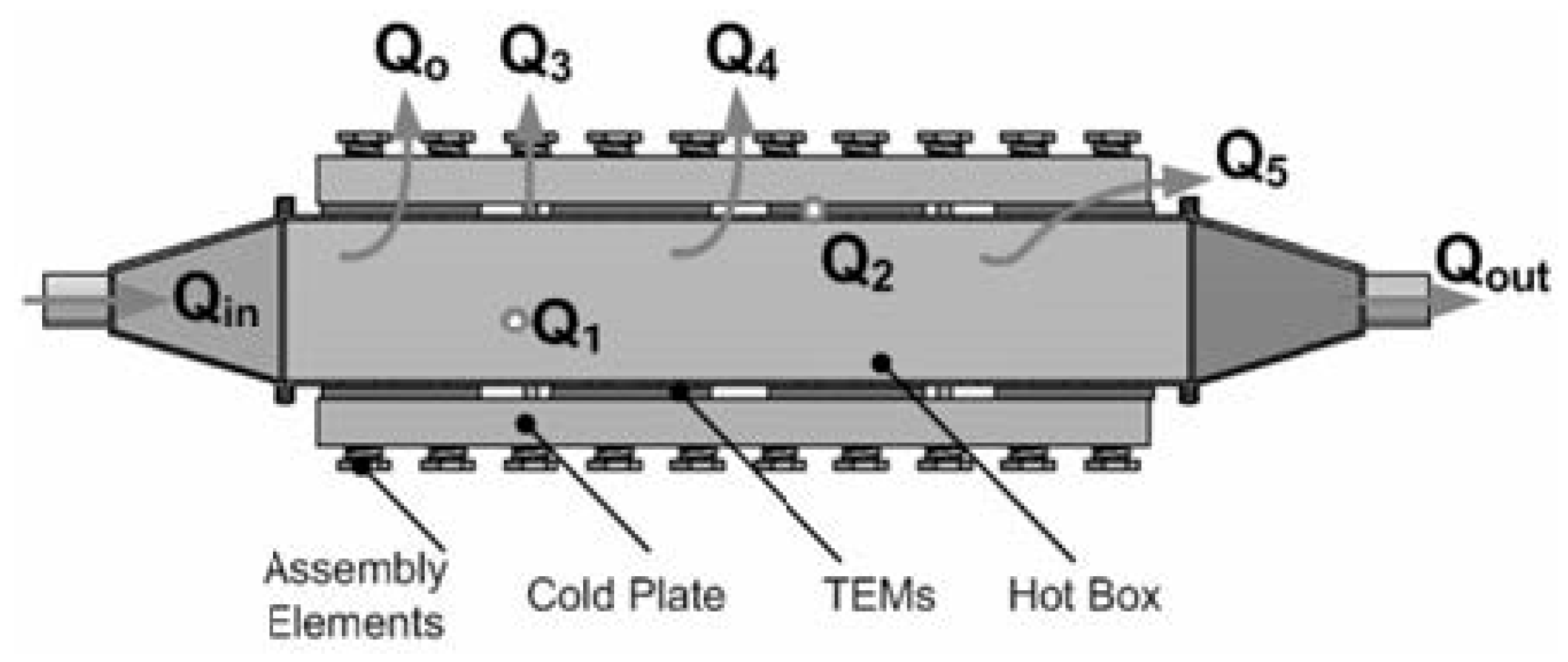
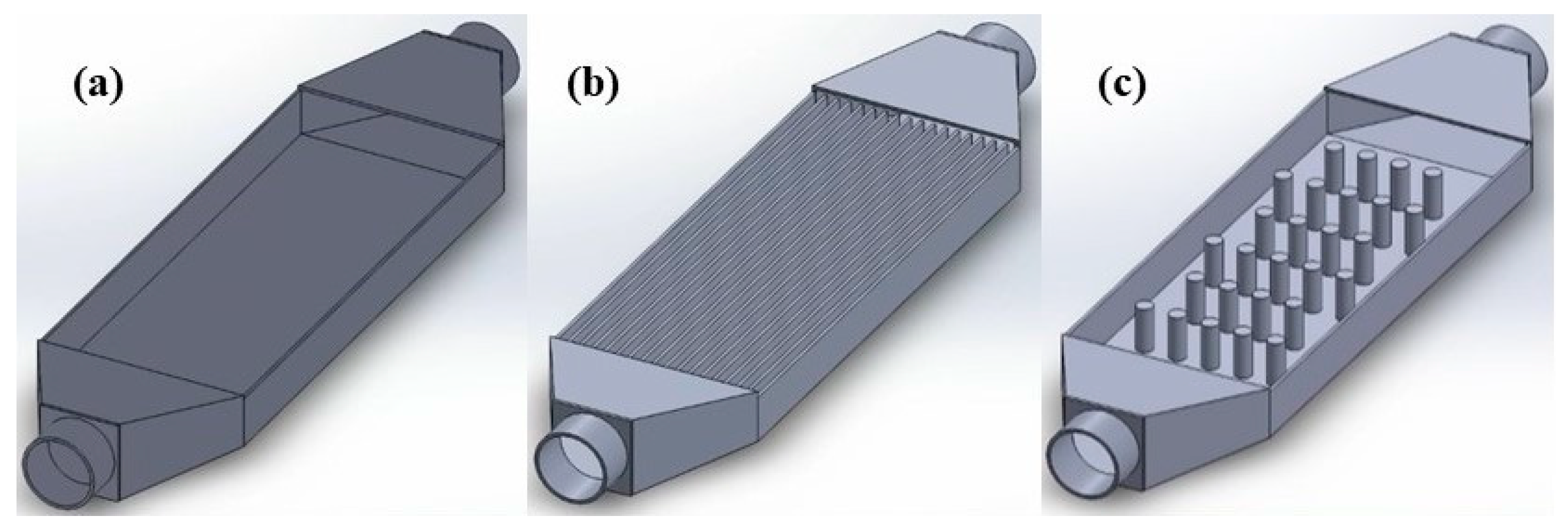
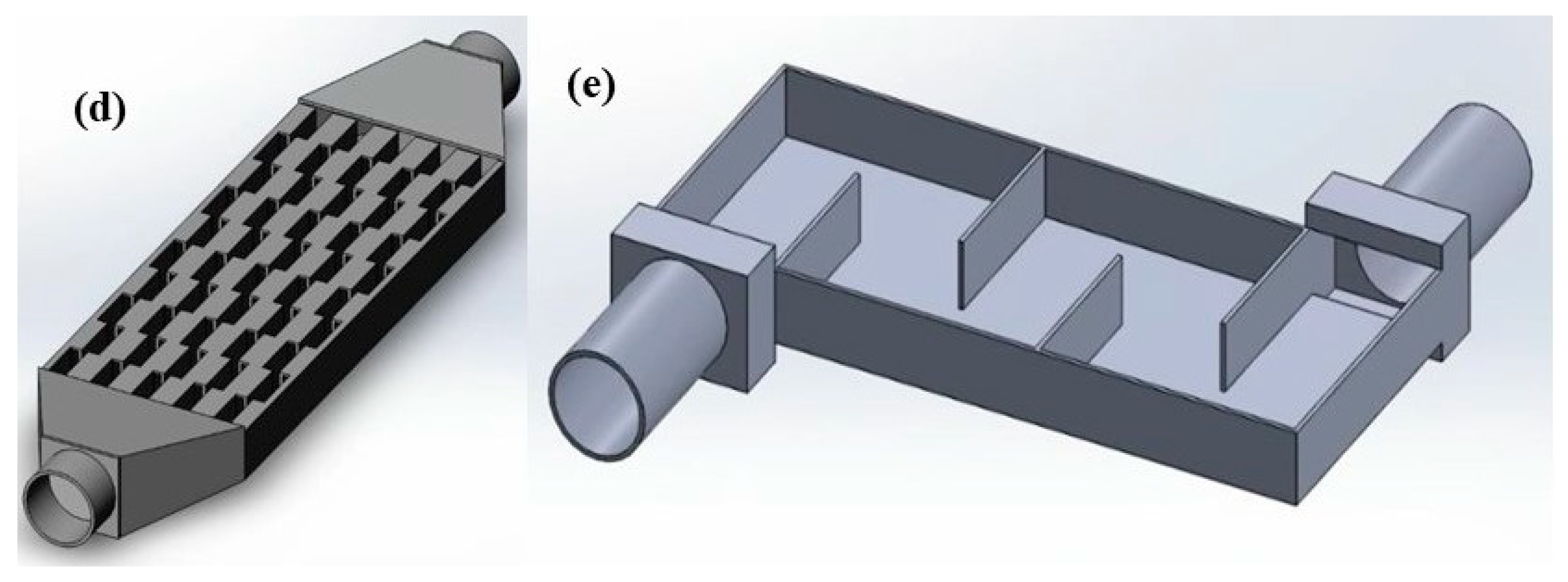

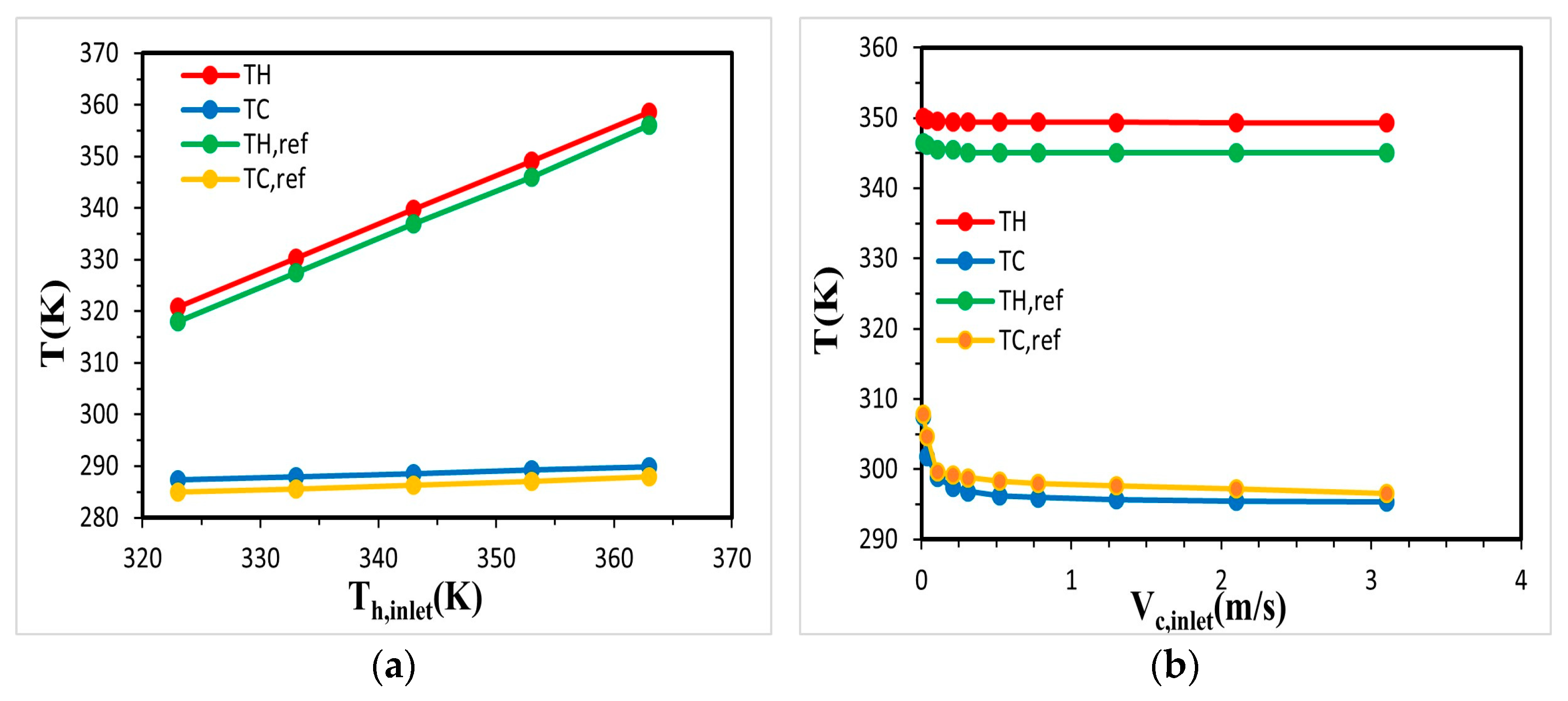
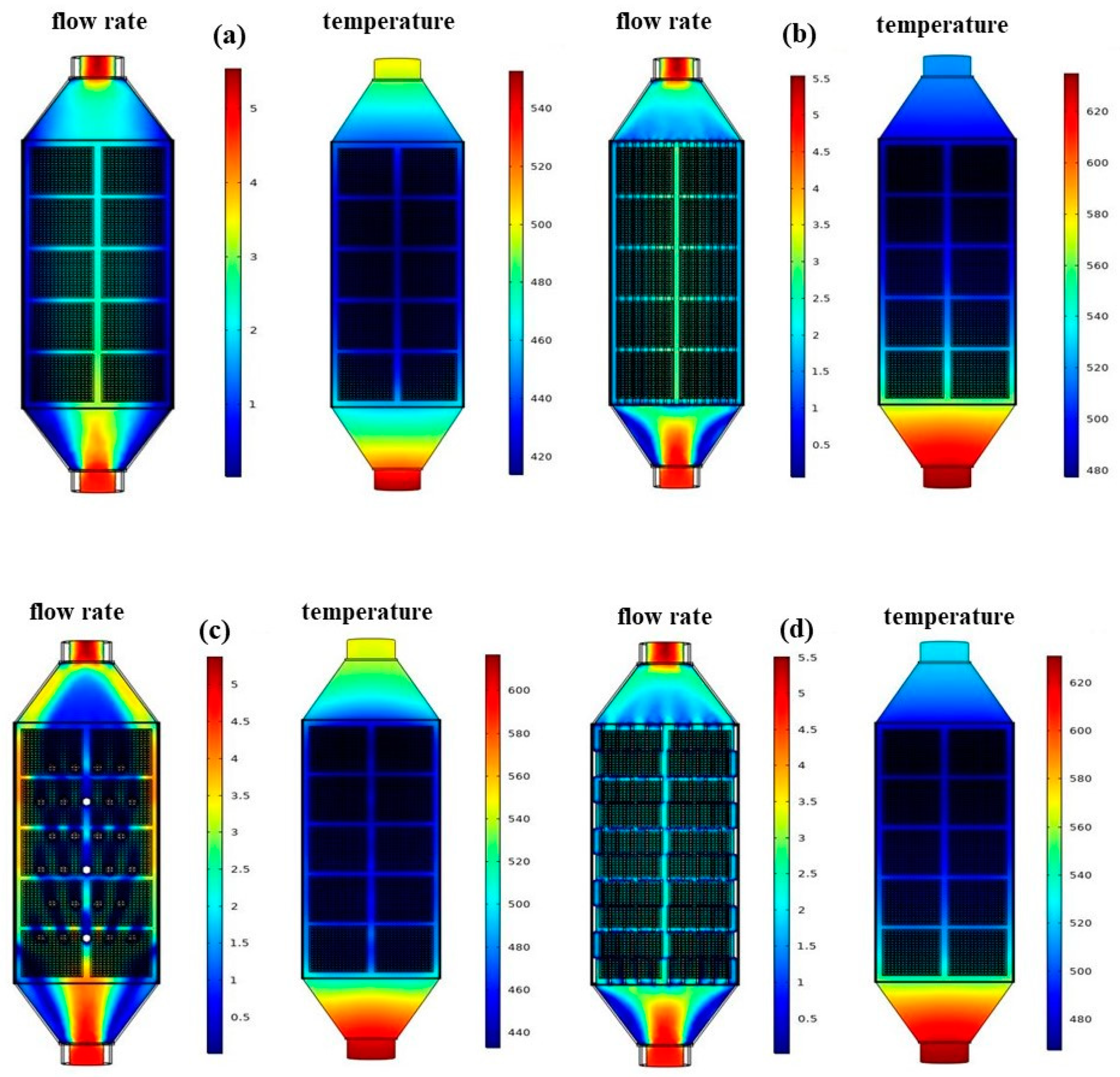
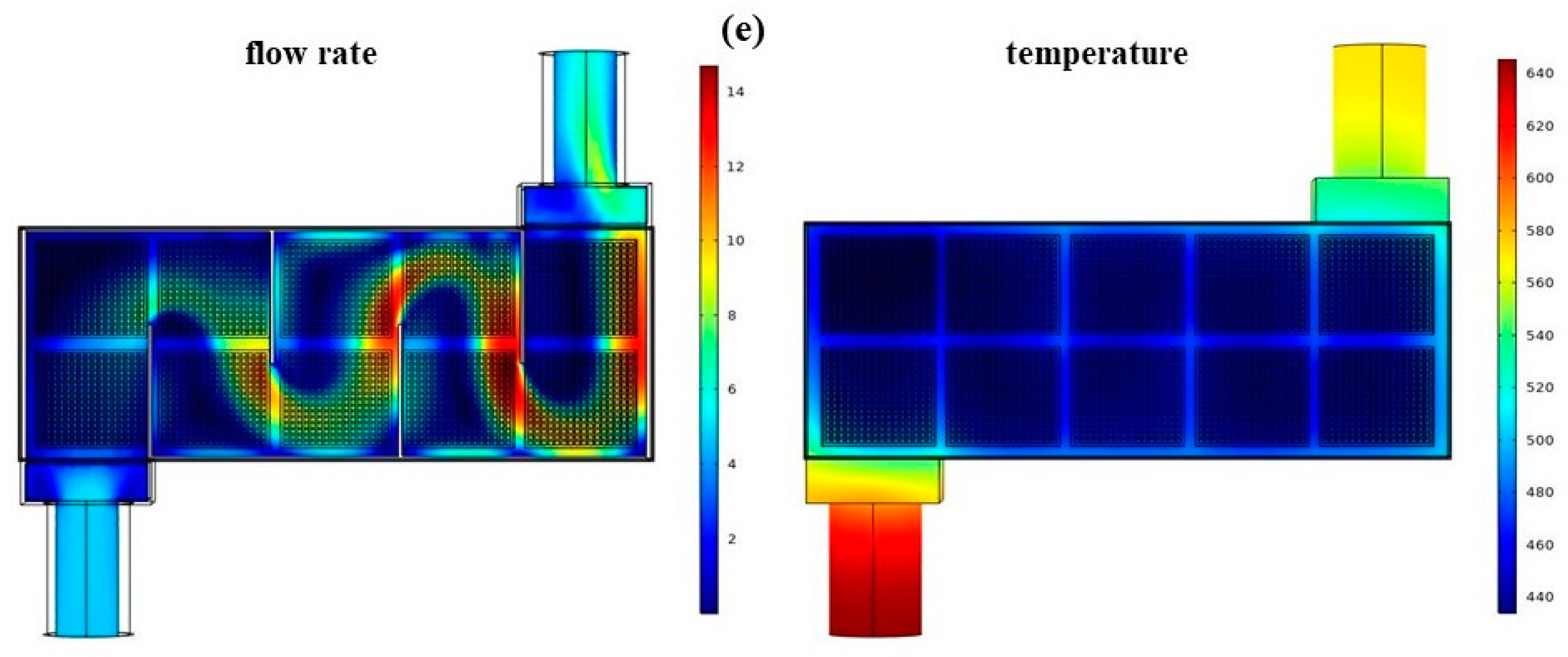
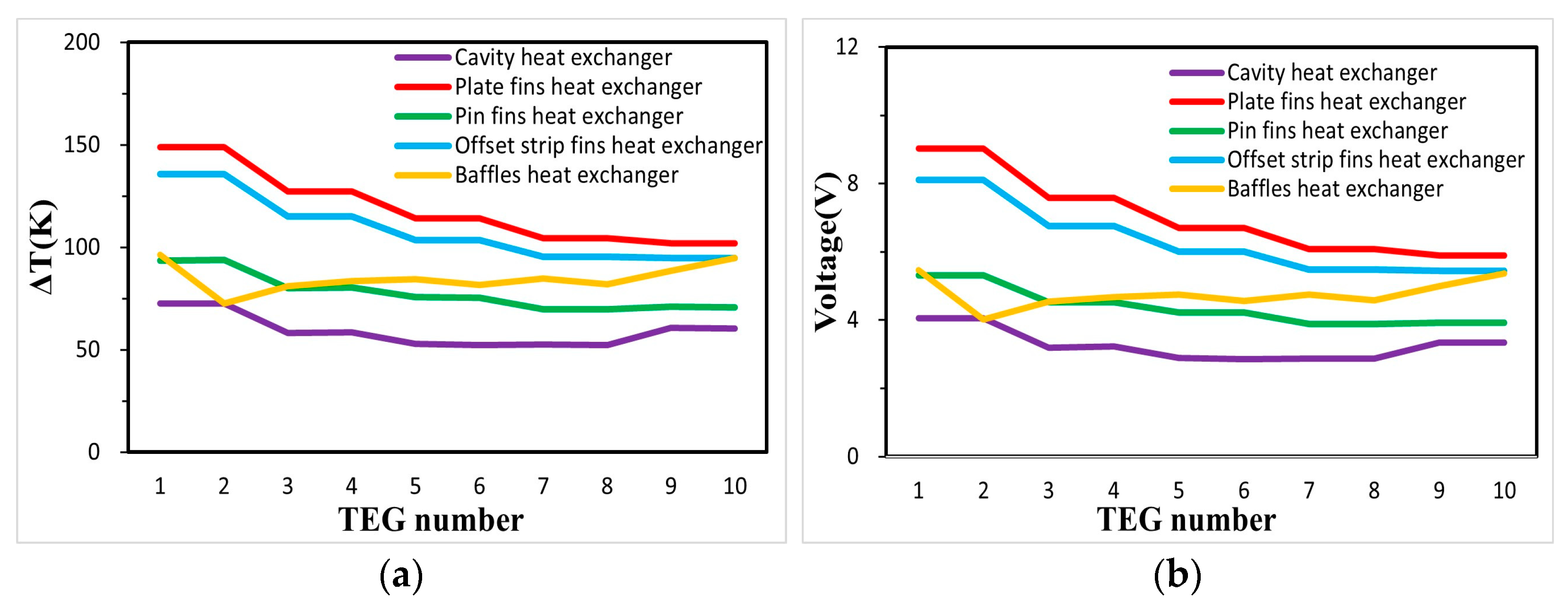
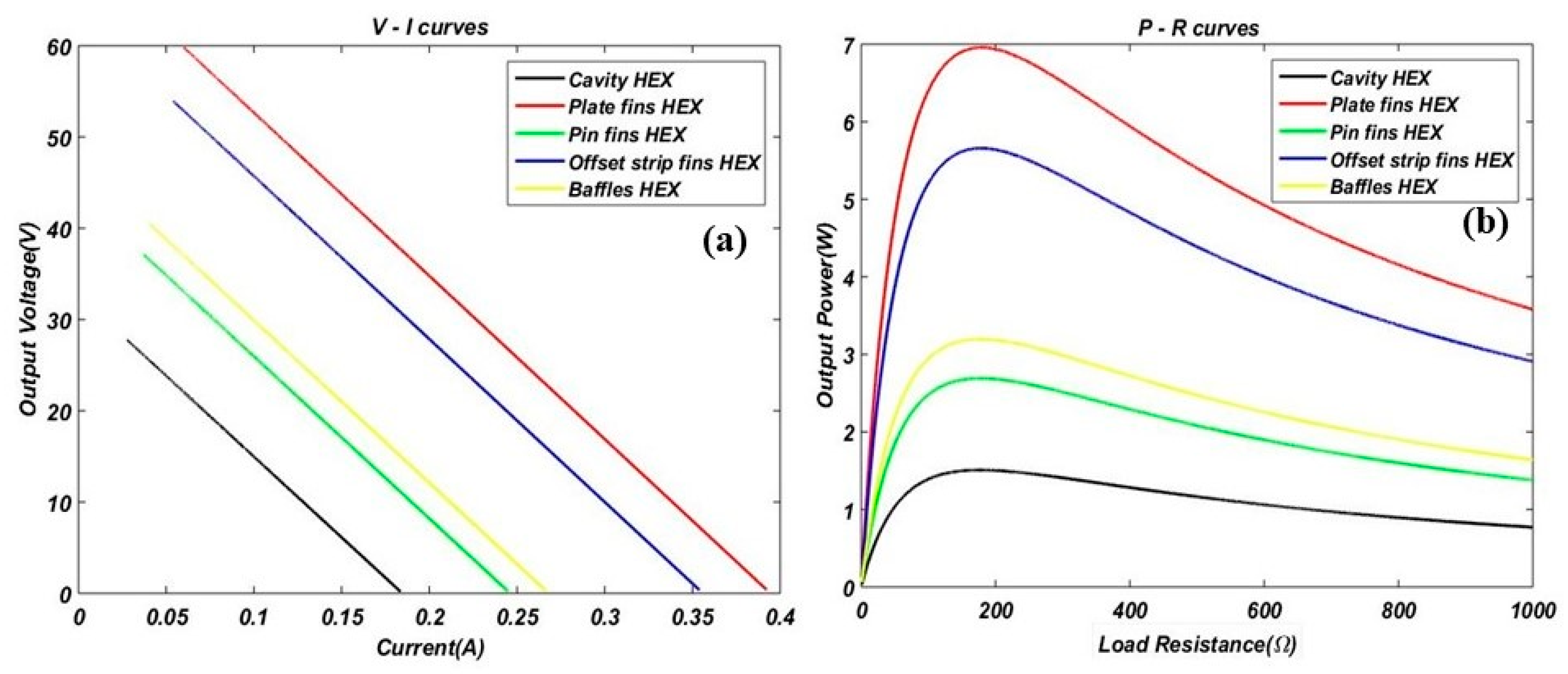

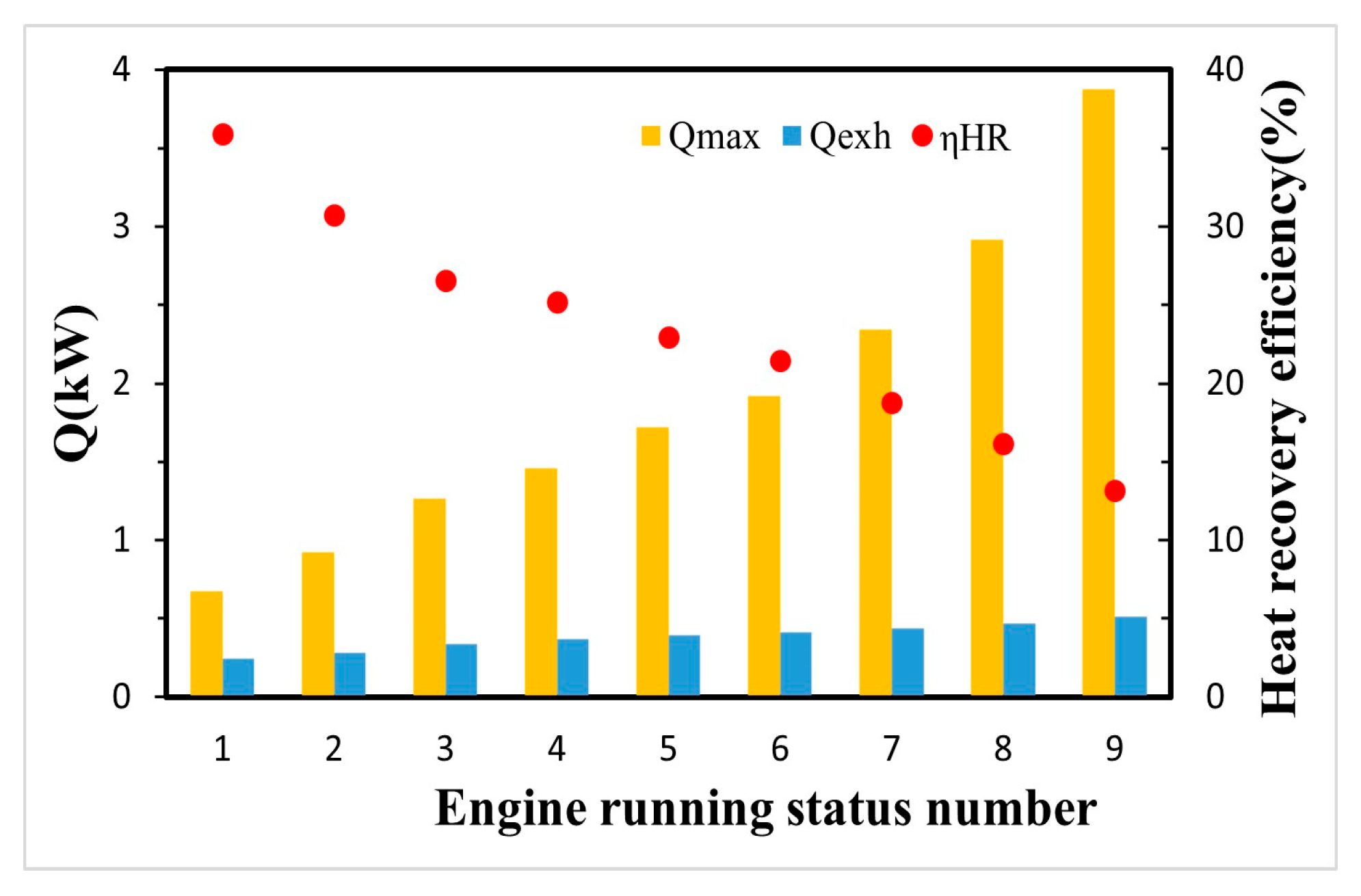
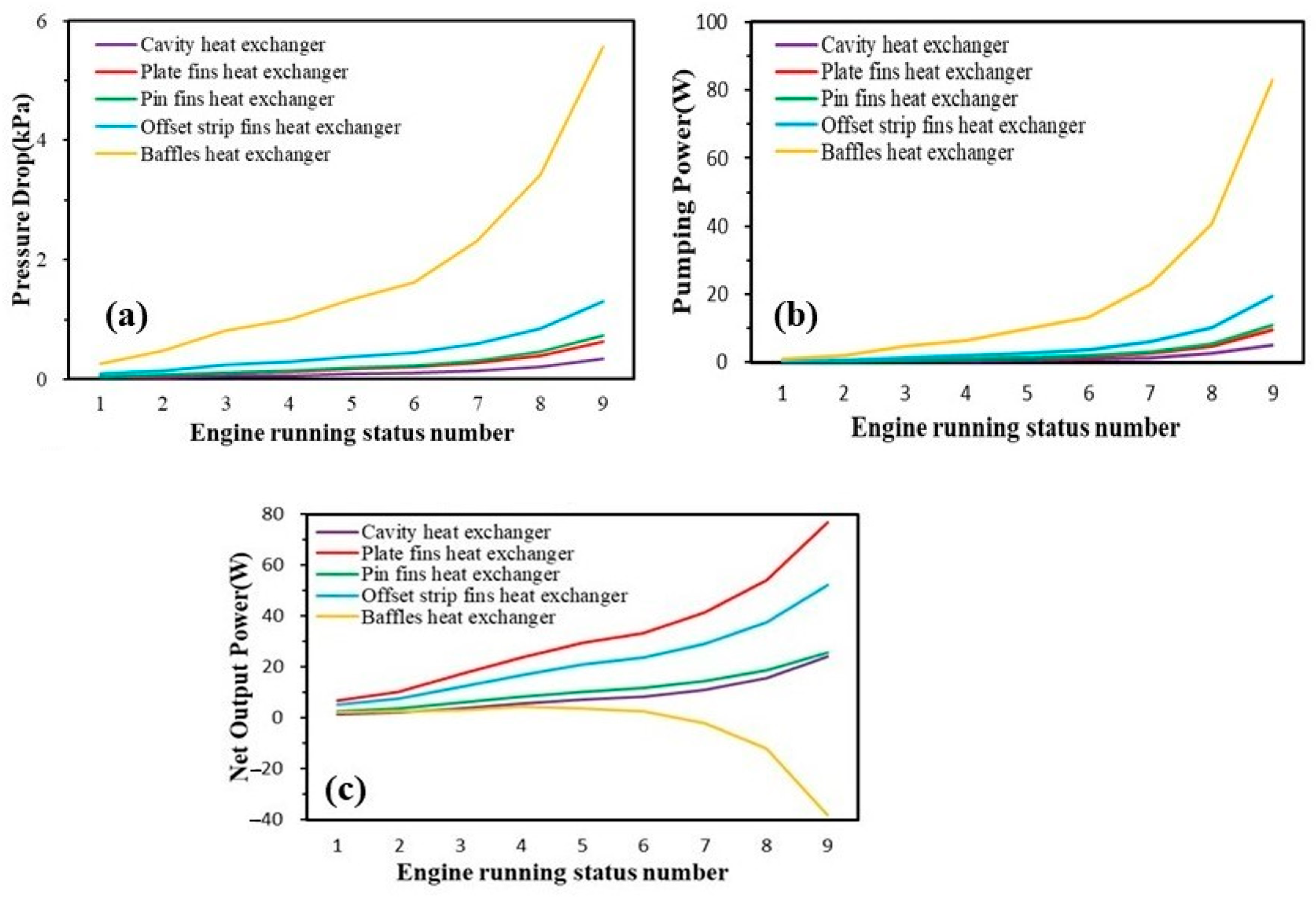
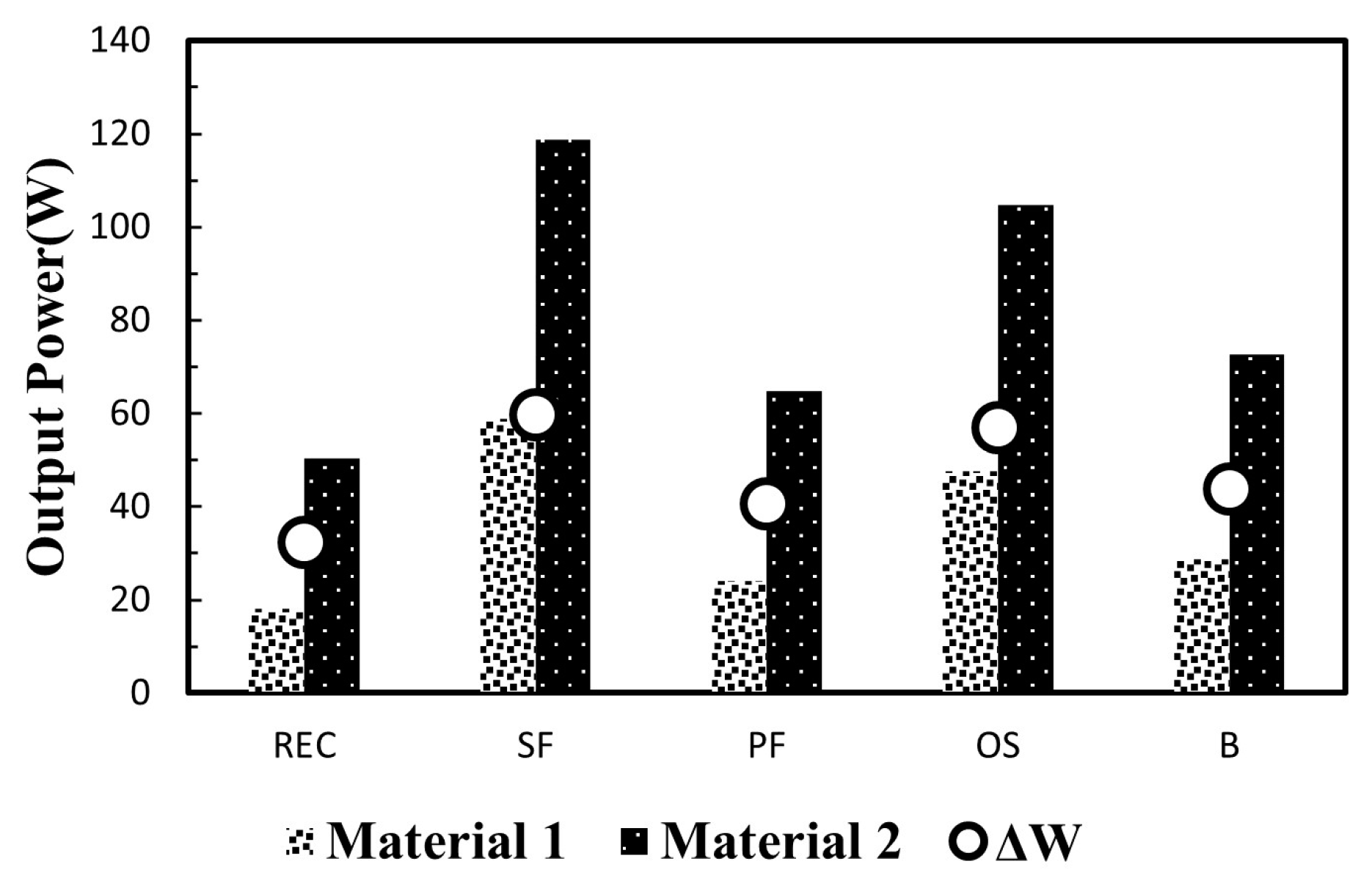
| Experimental Conditions | Exhaust Gas Mass Flow Rate (kg/h) | Simulation Exhaust Gas Mass Flow Rate (kg/h) | Exhaust Gas Temperature at TEG Inlet (K) |
|---|---|---|---|
| 1 | 39.3 | 6.288 | 675 |
| 2 | 51.8 | 8.288 | 688 |
| 3 | 63.5 | 10.160 | 733 |
| 4 | 66.5 | 10.640 | 775 |
| 5 | 74.6 | 11.936 | 798 |
| 6 | 80.9 | 12.944 | 811 |
| 7 | 93.4 | 14.944 | 839 |
| 8 | 107.7 | 17.232 | 879 |
| 9 | 128.2 | 20.512 | 942 |
Disclaimer/Publisher’s Note: The statements, opinions and data contained in all publications are solely those of the individual author(s) and contributor(s) and not of MDPI and/or the editor(s). MDPI and/or the editor(s) disclaim responsibility for any injury to people or property resulting from any ideas, methods, instructions or products referred to in the content. |
© 2024 by the authors. Licensee MDPI, Basel, Switzerland. This article is an open access article distributed under the terms and conditions of the Creative Commons Attribution (CC BY) license (https://creativecommons.org/licenses/by/4.0/).
Share and Cite
Chen, C.-Y.; Du, K.-W.; Chung, Y.-C.; Wu, C.-I. Advancements in Thermoelectric Generator Design: Exploring Heat Exchanger Efficiency and Material Properties. Energies 2024, 17, 453. https://doi.org/10.3390/en17020453
Chen C-Y, Du K-W, Chung Y-C, Wu C-I. Advancements in Thermoelectric Generator Design: Exploring Heat Exchanger Efficiency and Material Properties. Energies. 2024; 17(2):453. https://doi.org/10.3390/en17020453
Chicago/Turabian StyleChen, Cheng-You, Kung-Wen Du, Yi-Cheng Chung, and Chun-I Wu. 2024. "Advancements in Thermoelectric Generator Design: Exploring Heat Exchanger Efficiency and Material Properties" Energies 17, no. 2: 453. https://doi.org/10.3390/en17020453
APA StyleChen, C.-Y., Du, K.-W., Chung, Y.-C., & Wu, C.-I. (2024). Advancements in Thermoelectric Generator Design: Exploring Heat Exchanger Efficiency and Material Properties. Energies, 17(2), 453. https://doi.org/10.3390/en17020453







